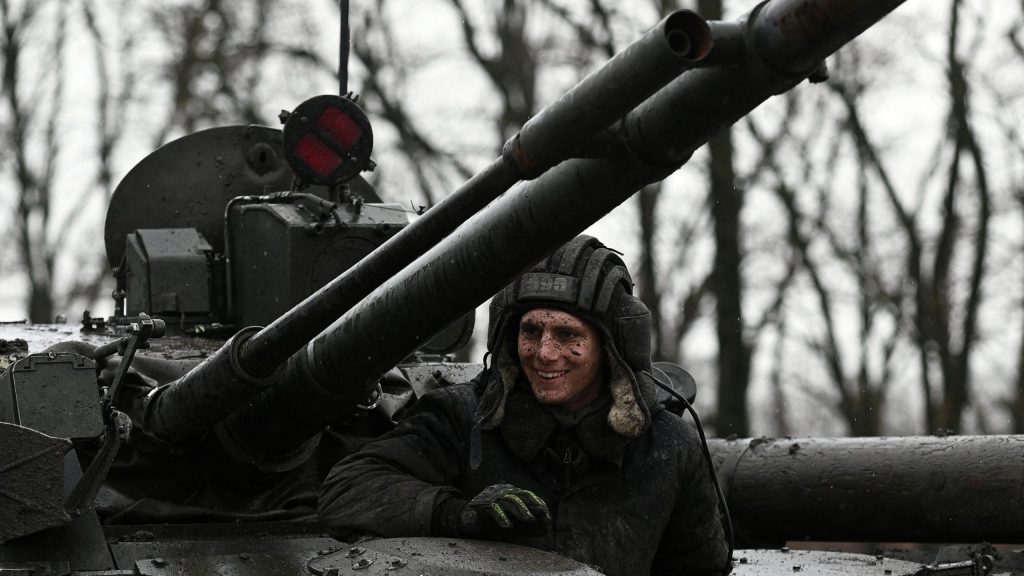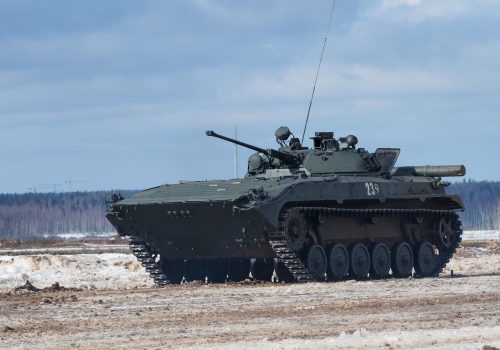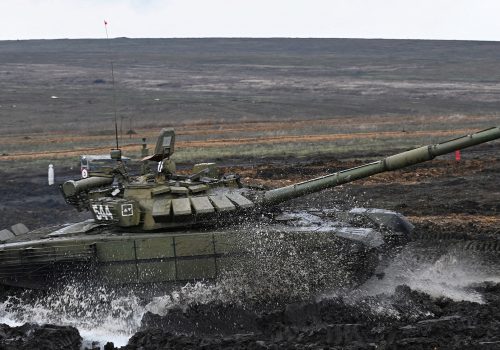In light of the ongoing Russia crisis, the Scowcroft Center’s Forward Defense (FD) practice will share weekly assessments of the latest force developments surrounding Ukraine, leveraging the expert perspectives of our senior military fellows. The opinions, conclusions, and recommendations expressed or implied here are solely those of the authors and do not necessarily represent the views of the Department of Defense or any other US government agency.
The bottom line
Russia continues to bolster its forces in Belarus, Crimea, and along the border with Ukraine. Those forces are now at a heightened state of readiness, with satellite imagery indicating field operations and ongoing live-fire exercises, including with artillery. Russia’s exercise in Belarus has so far focused on integrated air and ground operations. This signals that a major focus of any operation would be air support to a mechanized offensive.
Jump to a section:
US, allied, and partner deployments
Russian force movements
Air: Russia is significantly expanding its air-to-ground fighter force in the region and its training to conduct air support to ground forces in preparation for a possible large-scale mechanized invasion of Ukraine.
- On February 3, the Russian Ministry of Defense (MoD) announced a live fire exercise by Su-25 and Yak-130 land attack aircraft at the Brestsky training ground in Belarus as part of their bilateral exercise (known in the Western press as Allied Resolve and by Russia as Union Courage). Significantly, the Russian MoD stated that the aircraft worked with a ground party, including airborne units, artillery fires, and army aviation strikes. Additionally, the MoD pointed out aerial reconnaissance from an unmanned aerial vehicle was used to generate the targets for the fighter-bomber aircraft.
- Russia deployed a squadron of Su-25SM aircraft to the Brest region of Belarus as part of Allied Resolve. The Su-25 (which NATO calls Frogfoot) is a ground-attack aircraft roughly analogous to the US Air Force’s A-10 Warthog. The “SM” variant of the aircraft includes improved precision attack and self-defense capabilities. Combined with the exercise announced on February 3, this deployment clearly signals support to ground operations will be a major focus of a potential further invasion of Ukraine.
- On February 6, Russia released video of two Tu-22M3 bombers (which NATO calls Backfires) over Ukraine. The M3 variant is the most upgraded variant of the long-range, supersonic, nuclear-capable bomber and can launch up to eight cruise missiles per aircraft (the Tu-22 is roughly analogous to the US B-1 Lancer, though the B-1 is subsonic and, as a result of the first Strategic Arms Reduction Treaty, is no longer nuclear-capable). The announcement of this bomber patrol over Belarus is likely designed to both demonstrate Russia’s potent bomber capabilities and provide an implicit threat of possible nuclear retaliation in a potential expanded Ukraine conflict with US and NATO forces.
Air Defense: Russia has established an anti-access/area denial (A2/AD) “bubble” on the border of Ukraine, designed to help Russia establish air superiority over Ukraine and deny Ukrainian airspace to US and other NATO aircraft.
- On February 4, the Russian MoD announced the deployment of an S-400 Division to training grounds near Brest, Belarus. The S-400 is Russia’s most advanced operational long-range surface-to-air missile (SAM) system, with a maximum range of 250 kilometers. (While there exists an S-400 missile capable of engaging targets to 400 kilometers, that missile is currently not considered operational.) These battalions will provide coverage for ground forces and airfields in Belarus, help cover the advance of an invasion force from Belarus, and engage Ukrainian aircraft operating over the capital of Kyiv or along the Ukraine-Belarus border. These SAM systems are lethal to both large, non-maneuvering targets such as intelligence, surveillance, and reconnaissance (ISR) and cargo aircraft, as well as fast-moving, highly maneuverable fighter aircraft. These systems will help Russia achieve air superiority over the Ukrainian Air Force within days of the start of a further invasion and will push US and allied ISR and cargo resupply aircraft out of Ukrainian airspace in the event of conflict.
The Ukrainian reaction
Ground/ Logistics: On February 1, Ukranian President Volodymyr Zelenskyy announced an increase in the size of the Ukrainian military by one hundred thousand troops over the next three years (a 40 percent increase over Ukraine’s 250,000 troops today).
- This announcement will likely result in an increased Ukrainian demand for US and NATO security cooperation, which would likely take the form of an increased requirement for military equipment and trainers.
US, allied, and partner deployments
On February 2, the US Department of Defense announced that the US Army will deploy two thousand US soldiers to reinforce NATO countries. Three hundred staff members from the XVIII Airborne Corps will deploy to Germany and 1,700 soldiers from the 82nd Airborne Division will deploy to Poland. Additionally, US European Command (EUCOM) will deploy one thousand Stryker Cavalry Soldiers from Germany to Romania. These additional ground forces are a signal of US commitment to NATO, but not enough to significantly impact the calculus of Russia regarding whether to attack Ukraine. The Department of Defense reiterated that 8,500 troops remain on heightened alert (a five-day versus ten-day deployment timeline). These units include combat formations, medical support, aviation support, and logistics support. The units identified were XVIII Airborne Corps, 82nd Airborne Division, 101st Airborne Division, and the 4th Infantry Division.
The US Air Force is reportedly sending four B-52 Stratofortresses to Royal Air Force Base Fairford in the United Kingdom as part of a Bomber Task Force mission. The Bomber Task Force mission is well-established and, according to US EUCOM, “demonstrates the US Air Force’s unique ability to rapidly deploy to unfamiliar airfields and integrate with NATO allies and coalition partners.” The deployment at this time of heightened tensions is likely designed to signal the United States’ resolve and demonstrate military strength in the face of continued Russian military build-up and bellicose statements.
NATO Air Command announced that Joint Terminal Attack Controllers (a ground operator who calls in air strikes in communication with airborne platforms) from eleven NATO nations have been conducting live training with aircraft flying from the USS Harry S. Truman aircraft carrier operating in the Mediterranean Sea as part of the Neptune Strike ‘22 NATO exercise. Such training is critical to the execution of close air support for ground forces and is likely meant to signal to the Russians that they are not the only ones focusing on aerial support to ground operations.
FD’s conclusion
Russia continues to build up forces; high-end military capabilities; combat enablers, such as intelligence, ISR, electronic warfare, mobile communications, and command-and-control vehicles; and combat-sustainment capabilities, including ammunition, vehicle maintenance, field medical sites, blood supplies, and security forces.
Though Russia could launch a near “no-notice” invasion at any time, it likely will continue to build up forces and capabilities for the next few weeks. Russia is not likely to begin large-scale offensive operations prior to the end of its announced exercise with Belarus on February 20. Check out our military assessment map here.
Meet our military fellows
Today’s assessment is brought to you by senior US Army fellow Col. Benjamin Johnson and Senior US Air Force fellow Lt. Col. Tyson Wetzel. The Scowcroft Center Military Fellows Program, housed within the Forward Defense practice, hosts military fellows from participating branches of the US military and the armed forces of US allies and partners each year as part of a twelve-month fellowship program.
Further reading
Tue, Feb 8, 2022
Russian Hybrid Threats Report: New evidence of accelerated military build-up near Ukraine
New Atlanticist By
The Council’s open-source researchers reveal the latest Russian troop, aircraft, and weapons movements around Ukraine, along with new Kremlin disinformation efforts.
Thu, Jan 20, 2022
Will Russia make a military move against Ukraine? Follow these clues.
Experts react By
Our military fellows from the US Army, Navy, Air Force, and Marine Corps give a sense of the movements from Russia that they're tracking most closely.
Tue, Feb 8, 2022
US adversaries have been mastering hybrid warfare. It’s time to catch up.
Hybrid Conflict Project By Marc Polymeropoulos, Arun Iyer
Bad actors are embracing hybrid warfare. Time is of the essence for Washington to seize the advantage.
Image: A Russian service member is seen on a BMP-3 infantry fighting vehicle during drills held by the armed forces of the Southern Military District at the Kadamovsky range in the Rostov region, Russia February 3, 2022. Photo by Sergey Pivovarov/REUTERS




